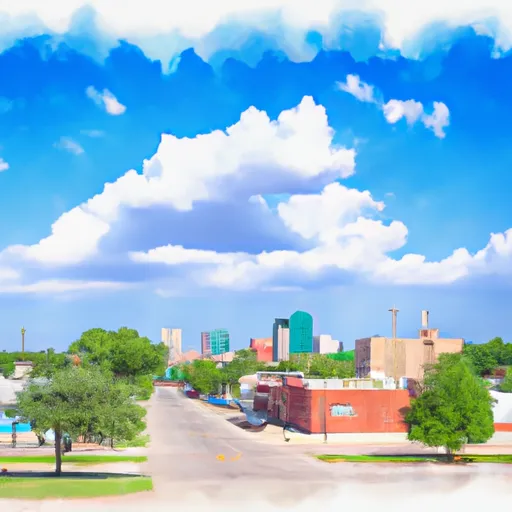-
 Snoflo Premium
Snoflo Premium
Get unlimited access to all our content
With no Ad interruptions! - Start Your Free Trial Login with existing account
Shawnee
Eden Index
Climate
8.3
•
Recreation
3.4
•
Community
2.1
•
Safeguard
5.0/10

Shawnee, Oklahoma, located in Pottawatomie County, boasts a humid subtropical climate characterized by hot summers and mild winters. Summers often see temperatures reaching the high 90s°F (around 37°C), while winter temperatures hover around the mid-40s°F (around 7°C). The area experiences moderate precipitation throughout the year, with an average annual rainfall of 41 inches (104 cm). Shawnee is prone to severe weather events such as thunderstorms and occasional tornados.
The city lies in close proximity to several water bodies, including the North Canadian River and several small creeks. These hydrological features contribute to a diverse array of outdoor recreation opportunities. Residents and visitors can enjoy fishing, boating, and swimming in nearby lakes such as Shawnee Twin Lakes or Lake Thunderbird. The area also offers opportunities for hiking, camping, and picnicking in parks like Wes Watkins Reservoir State Park and the Jim Thorpe Park. Nature enthusiasts can explore the diverse flora and fauna in the region, making Shawnee a great destination for outdoor activities.
What is the Eden Index?
The Snoflo Eden Index serves as a comprehensive rating system for regions, evaluating their desirability through a holistic assessment of climate health, outdoor recreation opportunities, and natural disaster risk, acknowledging the profound impact of these factors on livability and well-being.
Climate Health Indicator (CHI): 8.3
Shawnee receives approximately
994mm of rain per year,
with humidity levels near 80%
and air temperatures averaging around
17°C.
Shawnee has a plant hardyness factor of
7, meaning
plants and agriculture in this region tend to thrive during the non-winter months.
By considering the ideal temperature range, reliable water supplies, clean air, and stable seasonal rain or snowpacks, the Climate Health Indicator (CHI) underscores the significance of a healthy climate as the foundation for quality living.
A healthy climate is paramount for ensuring a high quality of life and livability in a region, fostering both physical well-being and environmental harmony. This can be characterized by ideal temperatures, reliable access to water supplies, clean air, and consistent seasonal rain or snowpacks.
Weather Forecast
Streamflow Conditions
Lower North Canadian
Area Rivers
Lower North Canadian
Snowpack Depths
Lower North Canadian
Reservoir Storage Capacity
Lower North Canadian
Groundwater Levels
Recreational Opportunity Index (ROI): 3.4
The Recreational Opportunity Index (ROI) recognizes the value of outdoor recreational options, such as parks, hiking trails, camping sites, and fishing spots, while acknowledging that climate plays a pivotal role in ensuring the comfort and consistency of these experiences.
Access to outdoor recreational opportunities, encompassing activities such as parks, hiking, camping, and fishing, is crucial for overall well-being, and the climate plays a pivotal role in enabling and enhancing these experiences, ensuring that individuals can engage in nature-based activities comfortably and consistently.
Camping Areas
| Campground | Campsites | Reservations | Toilets | Showers | Elevation |
|---|---|---|---|---|---|
| Walnut Creek Resort | 25 | 650 ft | |||
| Texoma Marina | None | 651 ft | |||
| Lebanon - Lake Texoma | None | 617 ft | |||
| Brier Creek - Lake Texoma | None | 656 ft | |||
| Sheppard AFB Military - Lake Texoma | None | 657 ft | |||
| Hickory Creek - Lake Texoma | None | 668 ft | |||
| Marietta Landing - Lake Murray State Park | None | 765 ft | |||
| Buncombe Creek - Lake Texoma | None | 659 ft | |||
| Cedar Bayou Marina - Lake Texoma | None | 647 ft | |||
| Juniper Point - Lake Texoma | None | 655 ft |
Catastrophe Safeguard Index (CSI):
The Catastrophe Safeguard Index (CSI) recognizes that natural disaster risk, encompassing floods, fires, hurricanes, and tornadoes, can drastically affect safety and the overall appeal of an area.
The level of natural disaster risk in a region significantly affects safety and the overall livability, with climate change amplifying these risks by potentially increasing the frequency and intensity of events like floods, fires, hurricanes, and tornadoes, thereby posing substantial challenges to community resilience and well-being.
Community Resilience Indicator (CRI): 2.1
The Community Resilience Indicator (CRI) recognizes that education, healthcare, and socioeconomics are crucial to the well-being of a region. The CRI acknowledges the profound impact of these elements on residents' overall quality of life. By evaluating educational resources, healthcare accessibility, and economic inclusivity, the index captures the essential aspects that contribute to a thriving community, fostering resident satisfaction, equity, and social cohesion.

